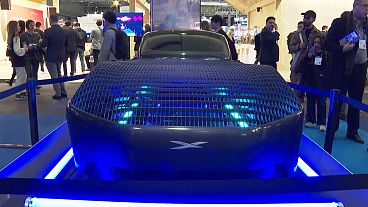Nine in 10 new cars sold in the country are electric or hybrid, compared to less than half of those sold in the EU. What’s Norway’s secret?
Norway is ending the sale of new petrol and diesel cars in two years, a decade ahead of the European Union.
The country leads the world when it comes to electric vehicle (EV) adoption, and its roads offer a glimpse of the future of mobility in Europe.
EVs already account for more than 20 per cent of all passenger vehicles in the country, and almost 84 per cent of new vehicles sold. When counting plug-in hybrids, the figure is close to 90 per cent, according to the Norwegian Road Federation (OFV).
“For all practical purposes, anything else than the electric passenger car is simply not interesting for the average new car buyer,” said its CEO Øyvind Solberg Thorsen.
“We are the first country to kill the combustion car,” he told Euronews Next.
By contrast, less than half of new cars sold in the EU are electric or hybrid. How did Norway get in pole position?
Norway’s electric 90s
According to Solberg Thorsen, Norway’s electric car journey began in earnest in the 1990s, when the country started supporting Think, a homegrown compact electric vehicle designed primarily for urban driving that Ford Motor owned for a few years.
At the time, Think “managed to persuade the Norwegian government to give them subsidies and to make the electric car exempt from all the car taxes,” he explained. “Electric cars drove for free on the toll roads, had free parking, and free access to the ferries”.
Battery-electric vehicles were also exempted from value-added and import taxes, which are traditionally high on cars in Norway.
All these incentives created a welcoming environment for Think and its vehicles to enter the market.
Then came Tesla
Initially, however, battery electric cars struggled to gain traction, “and it wasn’t until the market introduction of Tesla Model S [in 2012-2013] that things really started to happen,” said Solberg Thorsen, who has led the Norwegian Road Federation since 2006.
The Think City electric car had a relatively short range of 160 kilometres, and a top speed of around 100 km/h, while the Tesla S offered approximately 426 km on a single charge with a top speed of 209 km/h – along with more space and more luxurious features.
As the Tesla Model S gradually built its success, other car producers saw an opportunity and they too started to introduce battery electric cars.
“Then it all exploded,” said Solberg Thorsen.
“When the Nissan Leaf, the E-golf and also the Tesla Model S entered the market, we saw a real shift, and especially from 2018 and 2019 until today, there has been a very steep growth”.
The boom prompted the Norwegian parliament to reconsider the incentives and privileges that electric cars enjoyed, but “they still agreed it was very important to keep them,” and part of the explanation is that “of course, Norway is an oil-producing country,” said Solberg Thorsen.
“We thought that – and we still do – electrification of the road traffic is one of the major means to reach the Paris Agreement”.
The Paris Agreement, a legally binding international treaty on climate change adopted in 2015, establishes that countries must limit global warming to well below 2 degrees Celsius above pre-industrial levels and limit the temperature increase to 1.5°C above pre-industrial levels.
Incentives for EV purchases in Norway have in recent years become slightly less favourable than they used to, he added, but a growing environmental consciousness and more robust charging infrastructure have encouraged Norwegians to embrace electric cars as the primary mode of transportation.
A reliable charging network
The “main thing” that needs to happen to ensure a swift and true transition towards electric transport, according to the Norwegian Road Federation and the Norwegian Electric Vehicle Association, is establishing a comprehensive charging infrastructure.
An unreliable charging infrastructure and extended waiting times – especially during periods of peak demand – “have been an issue from the start,” said Petter Haugneland, assistant secretary general at the Norwegian EV Association, to Euronews next: “but the problem is diminishing”.
In the early stages of the electrification transition, between 2010 and 2015, it was “very difficult to find an electric charger along the main roads or in the cities,” he recounted. Most people charged their vehicles at home and used their EVs for commuting.
But as EVs started boasting bigger batteries and extended driving ranges – allowing drivers to use them beyond their daily commute and even to go on vacation – the need for more charging ports across the country became increasingly important.
“The new EVs customer group also wants to use the car for longer trips,” said Haugneland, “and also, of course, people living in apartment buildings that don’t have chargers at home also need a public charging offer, or at least be able to charge at work”.
And that is “something that we have been actively working on,” he added.
The Norwegian EV Association, also known as Norsk Elbilforening in Norwegian, is a nonprofit with over 120,000 members that pay a yearly fee to help promote the adoption and use of electric vehicles. In exchange, the organisation actively engages with policymakers to push for favourable policies and regulations for EVs.
Norsk Elbilforening has built a national charging database where they keep statistics of all the charging locations in the country. In their view, things are going “in the right direction”.
Norway has the third largest public fast-charging electric network in Europe after Germany and the UK, whose populations are over 10 times bigger.
Payment methods and user experience: The new challenge of EVs
The Norwegian Electric Vehicle Association estimates there is now approximately one fast charger for every 100 electric vehicles in Norway – enough to prevent range anxiety among new and would-be EV owners.
Haugneland says the sticking point that now requires attention is rather the complexity around EV charging payments and methods.
“The only thing in Norway you can’t pay with a credit or debit card is fast charging,” he said, adding that charging at different stations often entails “a jungle of different payment solutions”.
EV drivers in Norway must deal with different charging providers, each requiring registering to different platforms and apps. The process takes time and results in long queues at charging stations, said Haugneland.
“So this is something we are also working on,” he says, noting that the Norwegian Parliament had decided that all charging stations must include a card payment option from this year.
Will Europe ever catch up with Norway?
Solberg Thorsen said the future of electric vehicles in Norway looked “quite bright,” with the country on course to becoming fully electric “many years before Europe”.
“It will take some time, probably until 2040, until we see a major shift in Europe,” he predicted.
One of the challenges still preventing many Europeans from buying electric vehicles is that the initial purchase price can be significantly higher than conventional combustion vehicles.
But Haugneland is confident that as the second-hand market for electric vehicles expands, EVs will become more affordable and appealing to a broader audience.

















